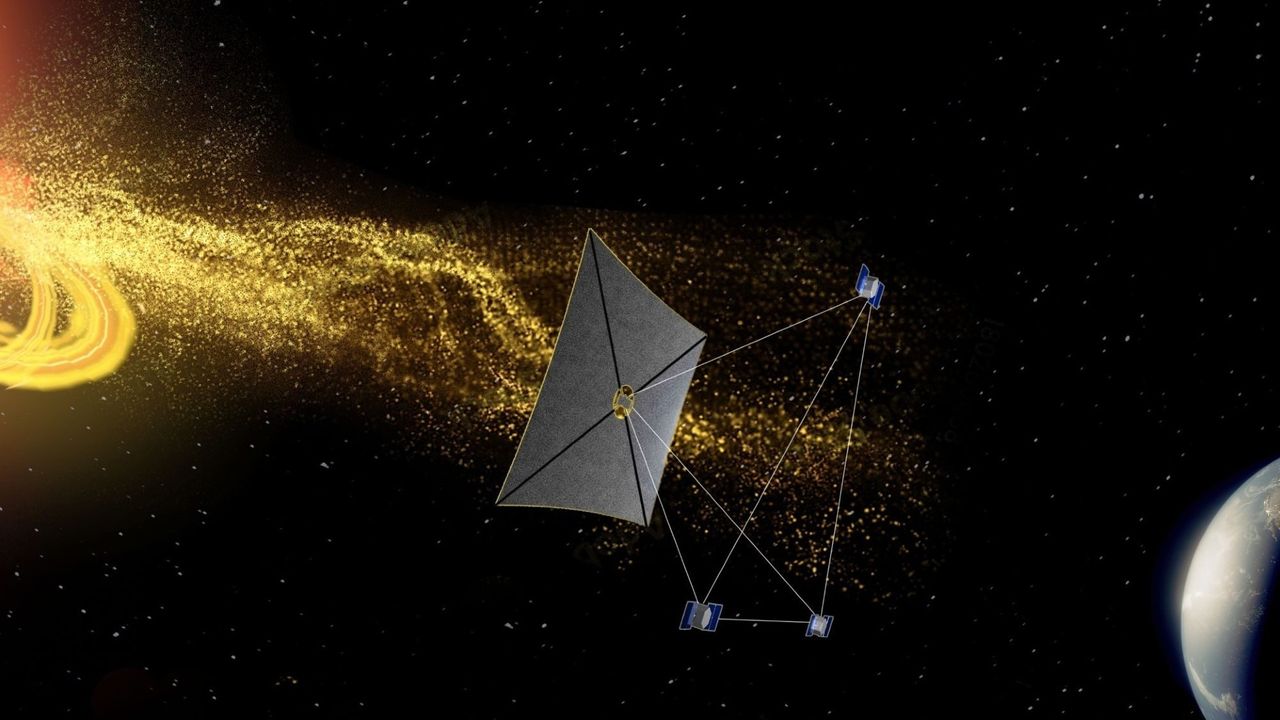
A fleet of guard spacecraft, including one with a significant solar sail, might look out for stealthy “area twisters” presenting a hazard to Earth during solar storms, a brand-new research recommends.
The proposal states that 4 deep-space spacecraft, collectively called Area Climate Examination Frontier (SWIFT), could accelerate “space weather condition” warnings by 40 %. While 3 spacecraft would certainly be powered by standard fuel, the 4th would have a solar sail approximately a third of the size of a football field.
That gigantic sail is required to maintain the fourth spacecraft in an uncommonly difficult orbit that provides it a better perch to see the sun’s tasks. However the job will certainly be worth it, scientists emphasize: Faster cautions for powerful, tornado-like plasma frameworks emerging from the sunlight would consequently help protect satellites , power lines and various other critical facilities from these solar eruptions.
These spacecraft are not funded, neither have they been officially created, so there is no strong estimate concerning how quickly they would certainly introduce or just how much they would certainly set you back. But the proposal, described in a study published in the peer-reviewed Astrophysical Journal on Monday( Oct. 6, provides an idea of how they would function. ( NASA and the National Science Foundation moneyed the research.)
To be sure, area companies consisting of NASA already have a number of sun-gazing spacecraft based to expect solar activity. The sunlight is currently in a very energetic duration in its 11 -year cycle, increasing the frequency of solar flares and coronal mass ejections
CMEs lugging electrons (charged particles) in the direction of Earth can move a lot more solar wind energy right into the magnetosphere (a component of our environment under specific problems , the National Oceanic and Atmospheric Administration (NOAA) states.
If the flow of solar fragments is strong, and if the electromagnetic field brought with the solar wind is streaming southward and contrary to Earth’s magnetic field, “there is a transfer of even more solar wind power right into the magnetosphere,” authorities created.
The energy from this solar wind can trigger damage if it interacts with satellites or high-voltage line– just like what took place in the province of Quebec in March 1989 , throughout a solar storm that plunged thousands into darkness during winter months.
Improving forecasts requires monitorings, so NASA and the European Room Company have actually spacecraft posted at Lagrange Point 1 or L 1– a gravitationally stable orbit in between Planet and the sunlight that makes use of a minimum of fuel.
Yet as the University of Michigan composes, these spacecraft can’t see everything: “A solar eruption aimed away from Earth, or with northward-pointing magnetic fields, might still toss vortices with southward-pointing electromagnetic fields towards Earth. Those hurricanes would certainly go unnoticed if they miss the probes posted at L 1”
The tornados are a lot more appropriately called” flux ropes”, and explain functions as tiny as 3, 000 miles long( 4, 828 kilometres) and as large as 6 million miles (9 5 million km) large.( For contrast, the range in between Earth and the sun is approximately 93 million miles or 150 million kilometres). The twisters are tough to also mimic: too small for CME researches, yet as well large for probes of magnetic fields and plasma bits.
The brand-new research, which scientists described as “extraordinary” in its resolution, consists of simulations demonstrating how twisters may occur. The sunlight is always sending out a” solar wind of charged bits across the solar system, however a CME ejection is much faster than that.
As a rapid CME presses its means into the slower solar wind, the wave of faster-moving bits can push aside “spinning masses of plasma, like a snowplow tossing snow,” according to the research. Several of these masses do break down quickly, but some linger as “hurricanes”.
The research study claims the recommended four-spacecraft constellation could spot these twisters on the fly. Researchers from the University of Michigan are leading the proposal, which would certainly put the four machines into a flying development formed like a pyramid. Each side of the “pyramid” would be roughly 200, 000 miles (322, 000 kilometres) long, which is almost the typical range between Earth and the moon.
The research recommends putting one spacecraft in each of the 3 edges of the pyramid’s base, which would be organized on a plane (a virtual, level surface area) around L 1 The 4th spacecraft is a bit of a grandfather clause. It would certainly function as a “hub”, and would certainly be positioned beyond L 1 and dealing with towards the sun.
That location beyond L 1 is as well unstable for the 4th spacecraft to utilize fuel to maintain itself, but it could use a substantial, aluminum solar sail that is about a 3rd of the dimension of a football field. But that’s thinking the success of a predecessor project for this sail concept, called Solar Cruiser. NOAA and NASA hope to obtain a rideshare launch for that spacecraft in 2029
Theoretically, that sail dimension is enough to “capture enough photons to maintain the spacecraft’s position, without shedding gas,” the college created. “This arrangement,” authorities included, “would certainly allow SWIFT to see exactly how the solar wind adjustments on its method to Earth, and its center closer to the sun could make room climate warnings 40 % faster.”
And the team highlighted how essential these spacecraft would certainly be in finding hurricanes: “Our simulation shows that the electromagnetic field in these vortices can be strong sufficient to activate a geomagnetic storm and create some genuine trouble,” added lead author Chip Manchester, a research study professor of climate and area scientific researches and design at the college.